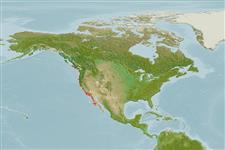>
Ovalentaria/misc (Various families in series Ovalentaria) >
Embiotocidae (Surfperches)
Etymology: Hyperprosopon: Greek, hyper = over + Greek, prosopon = face, snout of animal (Ref. 45335).
Environment: milieu / climate zone / depth range / distribution range
Ecología
marino demersal; rango de profundidad ? - 18 m (Ref. 2850). Subtropical; 52°N - 26°N, 130°W - 113°W
Eastern Pacific: Vancouver Island in British Columbia, Canada to central Baja California in Mexico, including Guadalupe Island (off northern central Baja California).
Tamaño / Peso / Age
Maturity: Lm ? range ? - ? cm
Max length : 30.0 cm TL macho / no sexado; (Ref. 2850); edad máxima reportada: 6 años (Ref. 56049)
Espinas dorsales (total): 8 - 10; Radios blandos dorsales (total): 25-28; Espinas anales 3; Radios blandos anales: 30 - 35; Vértebra: 33 - 37. Dark blue dorsally, sides and belly silvery with young having narrow golden vertical bars; tips of pelvic fins black; dusky on edge of caudal fin (Ref. 6885).
Live in surf on sand beaches and over sand near rocks, often around piers. Often occur in dense schools. Feed on small crustaceans. Viviparous, female carries the developing young (Ref. 205). Usually bear 5-12 young. An important game species.
Life cycle and mating behavior
Madurez | Reproducción | Puesta | Huevos | Fecundidad | Larva
Viviparous, female carries the developing young (Ref. 205).
Eschmeyer, W.N., E.S. Herald and H. Hammann, 1983. A field guide to Pacific coast fishes of North America. Boston (MA, USA): Houghton Mifflin Company. xii+336 p. (Ref. 2850)
IUCN Red List Status (Ref. 130435)
Threat to humans
Harmless
Human uses
Pesquerías: comercial; pesca deportiva: si
Más información
ReferenciasAcuiculturaPerfil de acuiculturaRazasGenéticaElectrophoresesheritabilidadEnfermedadesProcesamientoNutrientsMass conversion
Herramientas
Special reports
Download XML
Fuentes de Internet
Estimates based on models
Preferred temperature (Ref.
123201): 10.7 - 19, mean 12.8 °C (based on 115 cells).
Phylogenetic diversity index (Ref.
82804): PD
50 = 0.6250 [Uniqueness, from 0.5 = low to 2.0 = high].
Bayesian length-weight: a=0.01905 (0.00831 - 0.04372), b=2.97 (2.77 - 3.17), in cm total length, based on LWR estimates for this (Sub)family-body shape (Ref.
93245).
Nivel trófico (Ref.
69278): 3.5 ±0.50 se; based on food items.
Resiliencia (Ref.
120179): Medio, población duplicada en un tiempo mínimo de 1.4-4.4 años (tm=1; tmax=6).
Fishing Vulnerability (Ref.
59153): Low vulnerability (20 of 100).
